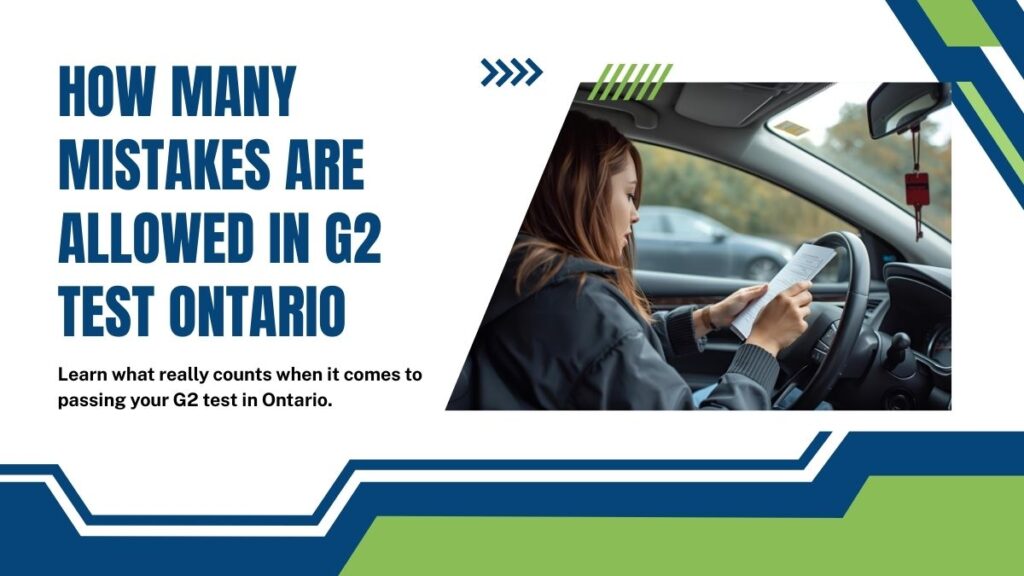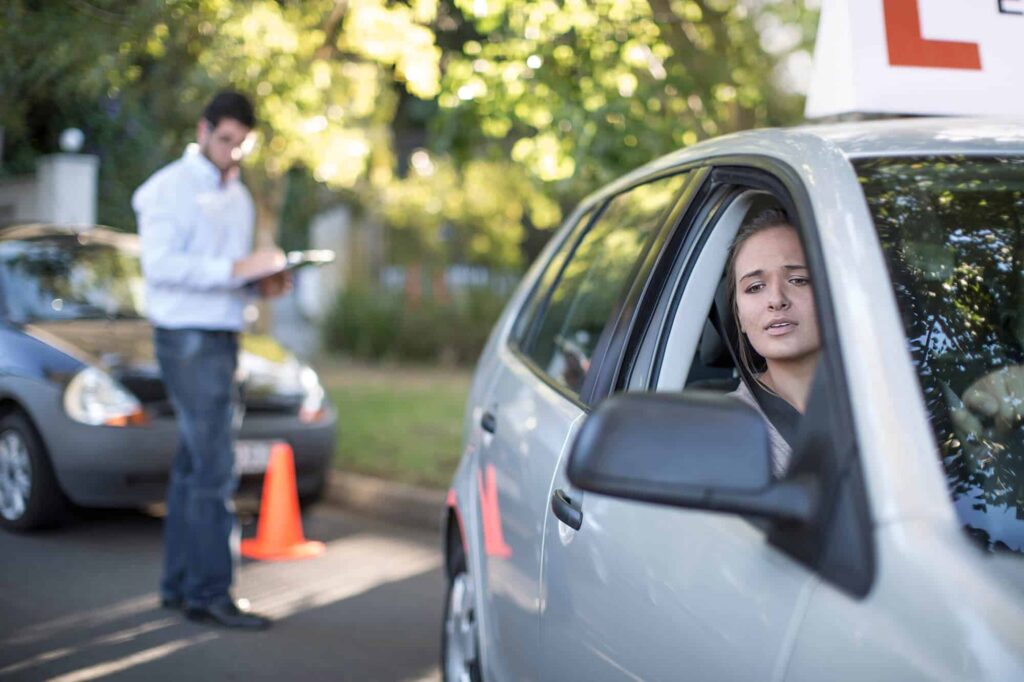Okay, let’s be real.
If you are reading this, you are probably a nervous soon-to-be driver in Ontario. Maybe you already have your G1, and now the big G2 road test is just around the corner.
The idea of sitting in the driver’s seat with an examiner beside you, silently jotting notes on a clipboard, can make anyone’s hands sweat.
And if you are like most new drivers, there is one thought running through your mind again and again: How many mistakes are allowed in G2 test Ontario? It is a fair question because nobody drives perfectly under pressure. The truth is, the G2 test is not about being flawless.
It is about showing that you can handle the road safely, make smart choices, and stay calm even if you make a few small mistakes along the way.
This guide will walk you through what examiners really look for, the difference between minor and major mistakes, and how to prepare so you can walk into your test feeling confident instead of stressed.
The Myth of a “Fixed Number of Mistakes”
Lots of people will tell you there is a set number. Some say you can only make 5 mistakes. Others swear the number is 10. The truth is different. The Ontario G2 road test does not have a strict cutoff. It works more like a scoring system.
Examiners use a detailed sheet to track what you do well and where you slip up. They are looking at your habits, your awareness, your ability to control the car, and above all, whether you can drive without putting yourself or anyone else in danger.
So no, there is no magic number. You can make several small errors and still walk away with your G2 license. But a single dangerous mistake can fail you instantly.
Minor Mistakes vs Major Mistakes
Not every mistake will cost you the test. The real difference is between minor mistakes you can recover from and major mistakes that stop you right away.
Minor Mistakes
- Forgetting a shoulder check once.
- Taking a corner a little wide.
- Stopping slightly past the line at a stop sign.
- Not canceling a signal right away.
- Braking too hard when you got nervous.
These will usually get marked but are not the end of the world if you are otherwise safe.
Major Mistakes (Automatic Fails)
- Running a stop sign or red light.
- Speeding significantly over the limit.
- Ignoring pedestrians or cyclists.
- Unsafe lane changes.
- Nearly causing a collision.
These show you are not ready to drive independently. One of these can end your test on the spot.
The “Safe Enough” Standard
Think of the G2 test less like a grade and more like a pass-fail safety check. The examiner is basically asking:
Would I feel safe if this person was driving alone tomorrow?
If the answer is yes, even with some small mistakes, you pass. If the answer is no because you showed unsafe judgment, you fail.
How many mistakes are allowed in G2 test Ontario?
It varies, but here is a rough idea from both my experience and what students have shared:
- You can usually make 5 to 10 small errors and still pass.
- Consistent repetition of the same mistake (like forgetting every single shoulder check) can push the examiner toward a fail.
- Small errors balanced by good overall control and observation are often forgiven.
Remember, the examiner is a human being. Some are stricter, some are more relaxed. But across the board, they are more concerned with safety than perfection.
Personal Story: My G2 Test at Downsview
Let me tell you about mine. I took my G2 at Downsview in Toronto, a test center that has a bit of a reputation for being tough. I was nervous, no sugarcoating it. On the first turn out of the parking lot, I forgot a shoulder check. Examiner scribbled. My stomach sank.
Later on, I hesitated at a four-way stop. The car behind me honked. The examiner scribbled again.
By that point, I thought it was over. But I kept going. I focused on driving smoothly and safely. At the end, the examiner told me, “You need to be quicker at intersections, but overall, you are safe.” And I passed.
That is the point. Mistakes did not kill me because I was cautious. I did not endanger anyone. And that is what they want to see.
Must Check: How to Pass the G2 Driving Test in Ontario
Common Mistakes Beginners Survive
From my experience as an instructor, here are the most common slip-ups that do not automatically mean failure:
- Being too slow when merging.
- Stopping longer than necessary at a green light.
- Not adjusting mirrors properly at the start.
- Forgetting to cancel the turn signal after a lane change.
- Braking too early or too suddenly.
Examiners see this all the time. As long as you are not unsafe, you can survive these.
Mistakes That Fail You Instantly
These are the ones students need to take seriously:
- Forgetting to check for pedestrians before turning.
- Speeding 10 km/h or more above the limit.
- Running a yellow light when it was safer to stop.
- Not yielding during a left turn and cutting someone off.
- Weaving between lanes or driving distracted.
One of these and you can almost guarantee a fail.
The Highway Portion
A unique part of the G2 test is the highway section. This part often stresses people out the most. The examiner will want to see that you can:
- Merge confidently without crawling or hesitating.
- Maintain the correct speed limit.
- Make safe lane changes with mirrors and shoulder checks.
- Exit the highway smoothly.
If you botch a merge badly or forget a blind spot check, it can cost you the whole test.
The Psychology of Mistakes
Here’s something important: the way you react to mistakes matters almost as much as the mistakes themselves.
If you forget a signal once, fine. But if you panic, slam the brakes, and spiral into more errors, that is when it becomes a problem.
I always tell my students this: treat mistakes like speed bumps. Feel them, acknowledge them, but keep going forward. Do not let one mistake poison the rest of your drive.
Must Check: How to Pass the G2 Driving Test in Ontario
Survival Tips for the G2 Test
- Do not count your mistakes while driving. Stay focused on the road.
- Think safe, not perfect.
- Use little self-talk to keep yourself steady. I whispered “mirror, signal, shoulder check” out loud to myself. It works.
- Treat the examiner like a GPS, not a judge.
What Students Often Say After Failing
I have heard this so many times:
- “I forgot one shoulder check and failed.”
- “I went too slow on the highway.”
- “I got nervous and froze at a left turn.”
Most of the time, the problem was not the single mistake. It was that the mistake showed a lack of readiness or created a safety risk. Going too slow on a highway, for example, is not a minor issue. It can be dangerous.
Why Professional Lessons Help?
Practicing with friends or family is good, but it can only take you so far. Professional instructors at an MTO Approved Driving School in Toronto know the exact skills examiners look for. They run mock tests on the same routes. They drill in shoulder checks, mirror checks, and highway merges until they become second nature.
Many students have told me that learning at the Best Driving School in Toronto gave them the edge to pass. It is not about memorizing tricks. It is about building safe habits and confidence so you do not freeze under pressure.
Frequently Asked Questions
Can you fail the G2 test for driving too slow?
Yes. Driving too far under the limit makes traffic unsafe and shows a lack of confidence. Examiners expect you to stay close to the posted speed and flow with traffic while staying safe.
How long is the G2 test in Ontario?
It usually lasts 20 to 30 minutes. You will do city driving, lane changes, turns, parking, three-point turns, and a short highway section to show you can handle different situations.
Do examiners tell you if you failed during the test?
No. Even if you make a big mistake, they let you finish. Results are given at the end when they explain what went well and what needs work.
What happens if you fail?
You can book again after 10 days. There is no set limit on tries, but each attempt costs a fee, so it helps to practice the weak spots before rebooking.
Do examiners expect perfection?
No. They do not expect flawless driving. What they want is safe habits, good awareness, and steady control, even if you make small errors.
Can you pass if you miss several shoulder checks?
Missing one or two may not ruin your test. But if you keep forgetting, it shows unsafe habits and can cause a fail. Examiners want you to always be aware of blind spots.
Do weather conditions affect grading?
Yes. In rain or snow, examiners know it is harder to drive. They expect slower speeds, longer stopping distances, and extra caution, but they still want to see safe and confident driving.
Final Thoughts
So, how many mistakes are allowed in the G2 test in Ontario? Enough that you do not have to drive flawlessly. Not enough to be careless.
You can make multiple small mistakes, sometimes even ten or more, and still pass. But one big dangerous mistake is usually the end.
Remember, the G2 test is not about being a perfect driver. It is about showing the examiner you can handle Ontario roads safely, even when you mess up a little.
And if you do fail, do not beat yourself up. Thousands of drivers fail the first time. What matters is that you keep learning, keep practicing, and come back stronger. Because that is what driving really is. Messing up, correcting yourself, and getting better with every single drive.






